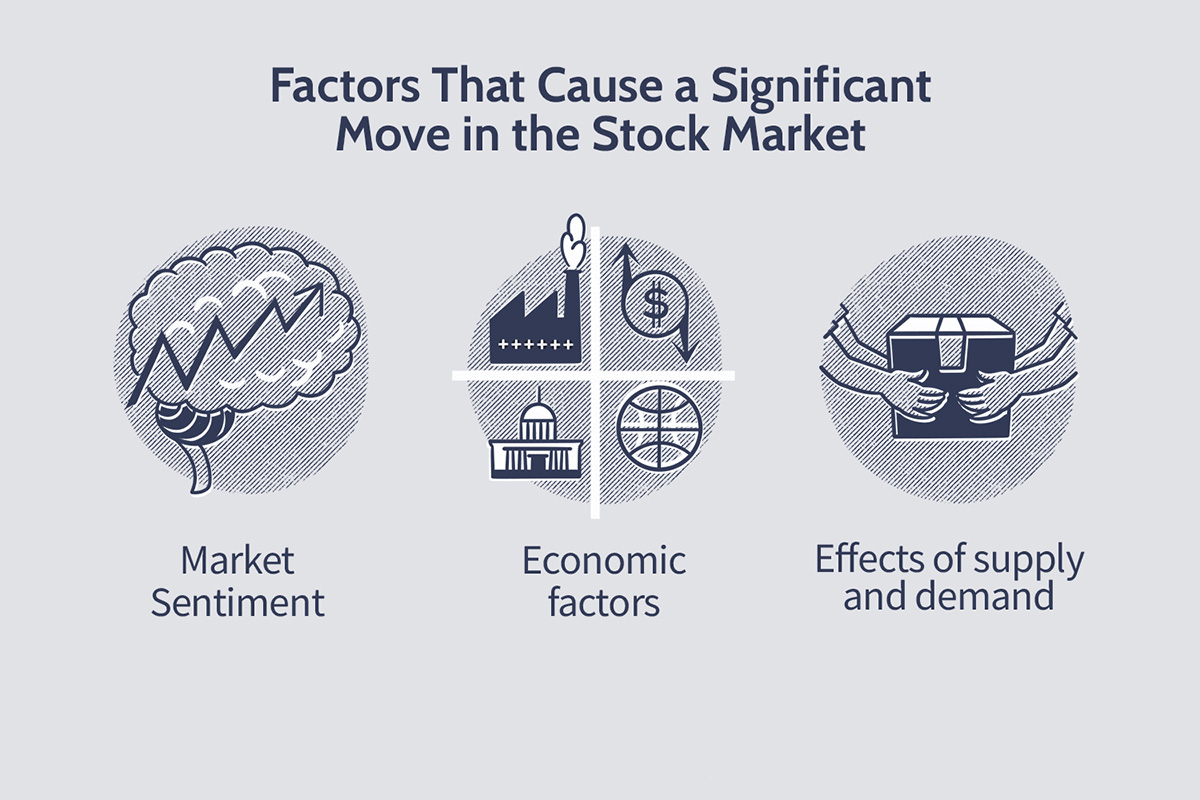

Finance
Why The Chinese Stock Market Crashed
Published: November 24, 2023
Discover the reasons behind the recent crash of the Chinese stock market and its impact on the world of finance.
(Many of the links in this article redirect to a specific reviewed product. Your purchase of these products through affiliate links helps to generate commission for LiveWell, at no extra cost. Learn more)
Table of Contents
Introduction
The Chinese stock market crash of [year] sent shockwaves throughout the global financial system, leading to widespread concern and uncertainty. In a matter of days, trillions of dollars in market value vanished, leaving investors and governments scrambling to understand the root causes and potential consequences.
The Chinese stock market, also known as the Shanghai Stock Exchange (SSE) and the Shenzhen Stock Exchange (SZSE), is one of the largest and most important stock markets in the world. With millions of retail investors and a significant presence of institutional investors, it plays a crucial role in the Chinese economy.
However, the euphoria that had surrounded the Chinese stock market in the years leading up to the crash quickly turned into panic and chaos. The market had experienced an unprecedented and rapid rise, driven by factors such as easy credit, speculation, and government policies to encourage investment. As a result, stock prices skyrocketed to unsustainable levels, creating a bubble that was bound to burst.
The crash had far-reaching implications not only for investors but also for the Chinese government, which faced the daunting task of stabilizing the market and preventing a further decline. In response, the government implemented a series of extraordinary measures, including suspending trading, injecting liquidity, and restricting large shareholders from selling their stocks.
This article aims to provide an in-depth analysis of the factors that led to the Chinese stock market crash, the actions taken by the government to address the crisis, and the long-term impacts on the Chinese economy. Furthermore, we will explore the international repercussions of the crash and discuss the lessons learned from this pivotal event in the history of the Chinese stock market.
Overview of the Chinese stock market
The Chinese stock market is a vital component of the country’s financial system, providing a platform for companies to raise capital and for investors to participate in the growth of the Chinese economy. It consists of two main stock exchanges: the Shanghai Stock Exchange (SSE) and the Shenzhen Stock Exchange (SZSE).
The SSE is the larger and more prominent of the two exchanges, with a focus on large-cap companies and state-owned enterprises. It is considered the main indicator of the Chinese stock market’s overall performance. The SZSE, on the other hand, primarily caters to smaller, high-growth companies and is known for its vibrant and volatile nature.
Both exchanges operate under strict regulations imposed by the China Securities Regulatory Commission (CSRC). These regulations aim to ensure transparency, protect investor interests, and maintain the stability of the market. However, the Chinese stock market differs significantly from its Western counterparts in terms of market structure and regulatory framework.
One key aspect of the Chinese stock market is the presence of a large number of retail investors. Unlike in many other countries where institutional investors dominate the market, Chinese individual investors drive a significant share of trading volume. This retail investor participation creates a unique dynamic and can contribute to increased market volatility.
Another notable characteristic of the Chinese stock market is the high level of government involvement. The Chinese government has historically played an active role in shaping the direction of the market through various policies and interventions. This interventionist approach is intended to maintain stability, prevent excessive speculation, and support the broader economic objectives of the country.
In recent years, the Chinese stock market has experienced periods of rapid growth and significant volatility. It has attracted both domestic and international investors seeking to capitalize on the potential of the Chinese economy. However, this growth has also been accompanied by concerns over market manipulation, inadequate regulatory oversight, and the potential for excessive speculation.
Understanding the structure and dynamics of the Chinese stock market is crucial for comprehending the factors that contributed to the crash and the subsequent government responses. In the following sections, we will delve deeper into the specific factors that led to the Chinese stock market crash and explore the implications for investors and the broader economy.
Factors leading to the stock market crash
The Chinese stock market crash was the result of a combination of internal and external factors that created a perfect storm of instability and uncertainty. Understanding these factors is essential for gaining insight into the root causes of the crash. Here are some of the main factors that contributed to the Chinese stock market crash:
- Speculation and excessive leverage: A significant factor behind the crash was the widespread speculation and excessive use of leverage in the Chinese stock market. Many retail investors, fueled by the belief that the market would continue to rise indefinitely, borrowed heavily to invest, leading to inflated stock prices and an unsustainable market bubble.
- Inadequate regulatory oversight: The Chinese stock market has often been criticized for its inadequate regulatory oversight. The regulatory authorities were unable to effectively monitor and control the market, leading to rampant manipulation, insider trading, and fraudulent practices. These issues further exacerbated the instability in the market.
- Market volatility and panic selling: The high level of market volatility witnessed in the Chinese stock market played a significant role in the crash. As stock prices started to decline, panic selling ensued, with investors rushing to offload their shares to limit their losses. This mass selling intensified the downward pressure on stock prices, creating a vicious cycle of further declines.
- Global economic factors: The Chinese stock market crash was not isolated from the global economic environment. The slowdown in the Chinese economy, combined with concerns over global economic growth and geopolitical tensions, contributed to the decline in investor confidence and added to the overall market instability.
- Government interventions: Surprisingly, the government’s interventions to stabilize the market also played a role in exacerbating the crash. Measures such as the suspension of trading, restrictions on selling, and the involvement of state-owned entities created uncertainty and eroded investor confidence. The actions taken were viewed by many as desperate attempts to artificially prop up the market rather than addressing the underlying issues.
These factors, combined with other underlying structural weaknesses in the Chinese stock market, culminated in the crash and subsequent market turmoil. The crash served as a wake-up call, highlighting the need for fundamental reforms in the market to prevent similar crises in the future. In the next section, we will explore the government’s interventions and responses to the stock market crash and their effectiveness in restoring stability.
Government interventions and responses
When the Chinese stock market crashed, the Chinese government swiftly implemented a series of interventions and responses in an attempt to stabilize the market and restore investor confidence. These measures ranged from regulatory actions to direct market interventions. Here are some of the key government interventions and responses:
- Suspending trading: In an unprecedented move, trading on the Chinese stock exchanges was suspended multiple times during the market crash. This temporary halt in trading was aimed at preventing a further decline in stock prices and giving investors time to reassess their positions.
- Injecting liquidity: To address liquidity concerns and support market stability, the Chinese central bank, the People’s Bank of China (PBOC), injected massive amounts of liquidity into the financial system. This included providing short-term funding to brokerages and encouraging banks to lend to the stock market to prevent a liquidity crunch.
- Restricting selling: To halt the freefall in stock prices, the Chinese government imposed restrictions on selling, particularly for large shareholders and institutional investors. These restrictions were implemented to prevent a sudden and sharp decline in stock prices caused by mass selling.
- Encouraging stock buybacks: The Chinese government also encouraged listed companies to buy back their own shares to stabilize their stock prices. This provided support to the market by increasing demand and reducing selling pressure.
- Cracking down on market manipulation: In response to concerns over market manipulation and fraudulent activities, the Chinese government launched investigations and crackdowns on individuals and entities involved in illegal practices. This was aimed at restoring investor confidence in the integrity of the market.
Despite these interventions, the effectiveness of the government’s response to the stock market crash has been a subject of debate. While the immediate impact of the measures was to halt the steep decline in stock prices, some critics argue that the interventions created an artificial market environment and failed to address the underlying issues of overvaluation and excessive speculation.
Furthermore, the government’s actions raised concerns about the independence and credibility of the Chinese stock market. The heavy-handed interventions and restrictions on selling raised questions about the market’s ability to function freely and efficiently. Investors were left uncertain about the true value of stocks and the long-term prospects of the Chinese stock market.
Undoubtedly, the government’s interventions played a significant role in stabilizing the market in the short term. However, the long-term effects of the interventions and their impact on market dynamics and investor confidence remain to be seen. In the next section, we will explore the implications of the crash on the Chinese economy as a whole.
Impact of the crash on the Chinese economy
The Chinese stock market crash had significant implications for the broader Chinese economy. The crash not only affected investors and the financial sector but also had ripple effects throughout the economy. Here are some key impacts of the crash on the Chinese economy:
- Wealth erosion: The crash led to a substantial loss in wealth for investors, particularly individuals who had heavily invested in the stock market. This wealth erosion had a negative impact on consumer sentiment and spending, as people became more cautious about their financial situations.
- Business and investment confidence: The crash also eroded business and investment confidence in the Chinese economy. Companies and investors became wary of the volatile stock market and the overall stability of the financial system. This cautious sentiment affected investment decisions and slowed down economic growth.
- Banking sector vulnerabilities: The Chinese banking sector, which is closely interconnected with the stock market, faced increased risks following the crash. Many banks had significant exposure to the stock market through loans and investments, leading to concerns over their financial health and potential non-performing loans.
- Government debt: The Chinese government intervened heavily to stabilize the market, which resulted in increased government debt. The cost of the interventions, such as injecting liquidity and supporting troubled companies, put a strain on the government’s finances and raised concerns about the sustainability of the country’s debt levels.
- Reforms and regulatory changes: The crash prompted the Chinese government to recognize the need for reforms and regulatory changes to restore stability and prevent future crises. Efforts were made to enhance oversight, strengthen regulations, and improve corporate governance in the Chinese stock market. These reforms aimed to restore investor confidence and strengthen the long-term viability of the market.
While the crash had short-term negative effects, it also served as a catalyst for necessary changes in the Chinese economy. The focus shifted from a market-driven approach to a more balanced and sustainable model of growth. The Chinese government initiated structural reforms, including reducing reliance on excessive debt and promoting consumption-led growth.
Over time, the Chinese economy showed resilience and began to recover from the crash. The government’s commitment to implementing reforms and stimulating economic growth helped restore confidence and stabilize the economy. However, the crash highlighted the vulnerability and interconnectedness of the Chinese financial system. Continued efforts to address these vulnerabilities and promote sustainable economic growth will be crucial in mitigating the risks of future market downturns.
In the subsequent section, we will examine the international repercussions of the Chinese stock market crash and its impact on the global financial system.
International repercussions
The Chinese stock market crash had significant international repercussions, sending shockwaves throughout the global financial system. Here are some of the key international repercussions of the crash:
- Spillover effects on global markets: The crash in the Chinese stock market had an immediate impact on global markets. Major stock exchanges around the world experienced sharp declines as investors reacted to the turmoil in the Chinese market. This highlighted the interconnectedness of global financial markets and the vulnerability to contagion risks.
- Commodity prices: The crash had a profound effect on commodity prices, particularly those closely linked to Chinese demand. The slowdown in the Chinese economy and the uncertainty surrounding its future growth prospects led to a decline in commodity prices. This had implications for commodity-exporting countries and industries heavily reliant on Chinese demand.
- Emerging markets stability: Many emerging market economies, which had enjoyed strong growth driven by China’s expanding market, were impacted by the crash. The declining confidence in China’s economic outlook prompted investors to pull out capital from emerging markets, leading to currency depreciations, capital outflows, and increased borrowing costs.
- Global investor sentiment: The crash in the Chinese stock market rattled global investor sentiment and increased risk aversion. This translated into a flight to safer assets such as U.S. government bonds, resulting in lower borrowing costs for developed economies. Central banks around the world closely monitored the situation and adjusted their monetary policies accordingly.
- Reassessment of China’s economic growth: The crash forced a reassessment of China’s economic growth prospects. Investors and analysts scrutinized the health of the Chinese economy and the effectiveness of government policies. This led to a broader debate on the sustainability of China’s growth model and the potential challenges it faced in transitioning to a more consumer-driven economy.
The international repercussions of the Chinese stock market crash highlighted the interdependence and vulnerability of the global financial system. It underscored the need for closer international coordination and cooperation in managing financial risks and promoting stability. Furthermore, it prompted discussions on the need for diversification in investment portfolios and the importance of understanding and managing exposure to emerging markets.
In response to the crash, central banks and regulatory authorities in various countries adopted measures to mitigate the potential impact on their respective economies. These included adjusting monetary policies, enhancing financial regulations, and improving risk management practices. Cooperation between nations and international financial institutions played a crucial role in containing the fallout from the Chinese stock market crash.
In the final section, we will reflect on the lessons learned from the crash and the potential future outlook of the Chinese stock market.
Lessons learned and future outlook
The Chinese stock market crash served as a wake-up call and provided valuable lessons for policymakers, investors, and market participants. Here are some of the key lessons learned from the crash and the potential future outlook of the Chinese stock market:
- Importance of market stability: The crash emphasized the importance of market stability and the need for effective regulatory oversight. Strengthening market regulations, improving transparency, and enhancing investor protections are vital to maintaining a stable and functioning stock market.
- Managing market speculation: The excessive speculation and leverage that contributed to the crash underscored the need for prudent risk management practices. Investors and regulators should promote a sustainable and long-term investment mindset, discouraging excessive speculation and reducing the reliance on leverage.
- Structural reforms: The crash highlighted the importance of structural reforms in the Chinese economy. Focusing on reducing debt levels, promoting consumption-led growth, and enhancing the role of the private sector are crucial to building a more resilient and balanced economic model.
- International cooperation: The crash demonstrated the interconnectedness of global financial markets. Strengthening international cooperation and coordination among regulatory authorities is essential to managing financial risks, preventing contagion, and promoting global financial stability.
- Technological advancements: The future outlook of the Chinese stock market is closely tied to technological advancements. The adoption of financial technology (fintech) and the development of innovative financial products can enhance market efficiency, improve accessibility for retail investors, and foster a more inclusive and robust stock market.
Looking ahead, the Chinese stock market is expected to continue its evolution. Ongoing efforts to enhance market reforms, attract foreign investment, and increase the role of institutional investors are likely to shape its future trajectory. The gradual opening up of the Chinese capital market to international investors through schemes such as the Stock Connect program and the inclusion of Chinese A-shares in global benchmark indexes further signals the potential for increased integration with global markets.
However, challenges remain, including addressing lingering concerns over regulatory transparency, market manipulation, and investor protections. China’s ability to navigate geopolitical tensions, economic slowdowns, and external shocks will also be critical in determining the future stability and growth of its stock market.
While the Chinese stock market crash was undoubtedly a challenging period, it provided valuable lessons and paved the way for necessary reforms. By learning from past experiences and embracing a forward-looking approach, the Chinese stock market has the potential to further mature and contribute to the continued development of China’s economy and the global financial system as a whole.














